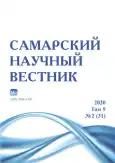Факторы деградации почв и атмосферного воздуха и их влияние на состояние растений в городских и пригородных экосистемах
- Авторы: Ларионов М.В.1, Ларионов Н.В.2, Громова Т.С.3, Сираева И.С.3, Ермоленко А.С.3, Володькин А.А.4, Левкина Г.В.5
-
Учреждения:
- Балашовский институт (филиал) Саратовского национального исследовательского государственного университета имени Н.Г. Чернышевского
- Котельниковская средняя общеобразовательная школа № 2
- Саратовский национальный исследовательский государственный университет имени Н.Г. Чернышевского
- Пензенский государственный аграрный университет
- Брянский государственный инженерно-технологический университет
- Выпуск: Том 9, № 2 (2020)
- Страницы: 78-85
- Раздел: Общая биология
- URL: https://journals.rcsi.science/2309-4370/article/view/41929
- DOI: https://doi.org/10.17816/snv202113
- ID: 41929
Цитировать
Полный текст
Аннотация
В статье представлены данные об особенностях и мощности деградации качества почв, атмосферного воздуха и растений в городских и пригородных территориях Нижнего и Среднего Поволжья, Центрального Черноземья. Цель – представить и подвергнуть анализу данные экомониторинга почв, атмосферы и растений. На примере Саратовской, Воронежской и Пензенской областей установлены значения состояния наземных экосистем на разных вариантах почв и почвогрунтов. Преимущественное положение по площади и хозяйственному использованию занимают преобразованные в ходе градостроительства почвы, а также искусственные грунты. Большое значение в деградации почвенного покрова имеют уплотнение, антропотехногенные включения, замусоренность, загрязнение тяжелыми металлами. В аэротехногенном загрязнении существенная роль заключена в образовании и осаждении пыли на листовой поверхности растений. Биоиндикационными признаками в анализе состояния окружающей среды и экологических систем служили показатели жизнеспособности, состояния и устойчивости деревьев и кустарников. Они получены по средневзвешенным данным исследований и последующей оценки жизненного состояния. Отдельно рассмотрены показатели деградации ассимиляционных органов древесных растений в зависимости от уровней неблагоприятных почвенно-экологических и аэрогенных условий в городских и пригородных экосистемах изученных регионов. Значимость деградации объектов окружающей среды проанализированными антропотехногенными факторами заключена в результатах корреляционного анализа.
Ключевые слова
Полный текст
Открыть статью на сайте журналаОб авторах
Максим Викторович Ларионов
Балашовский институт (филиал) Саратовского национального исследовательского государственного университета имени Н.Г. Чернышевского
Автор, ответственный за переписку.
Email: m.larionow2014@yandex.ru
доктор биологических наук, доцент, профессор кафедры биологии и экологии
Россия, Балашов, Саратовская областьНиколай Викторович Ларионов
Котельниковская средняя общеобразовательная школа № 2
Email: lnv0001@yandex.ru
кандидат биологических наук, директор
Россия, г. Котельники, Московская областьТатьяна Сергеевна Громова
Саратовский национальный исследовательский государственный университет имени Н.Г. Чернышевского
Email: gromova.tatiana2015@rambler.ru
аспирант кафедры ботаники и экологии
Россия, СаратовИрина Салаватовна Сираева
Саратовский национальный исследовательский государственный университет имени Н.Г. Чернышевского
Email: irina.siraeva@mail.ru
аспирант кафедры ботаники и экологии
Россия, СаратовАнна Сергеевна Ермоленко
Саратовский национальный исследовательский государственный университет имени Н.Г. Чернышевского
Email: berestnevaanna@mail.ru
аспирант кафедры ботаники и экологии
Россия, СаратовАлексей Анатольевич Володькин
Пензенский государственный аграрный университет
Email: volodkin.a.a@pgau.ru
кандидат сельскохозяйственных наук, доцент кафедры растениеводства и лесного хозяйства
Россия, ПензаГалина Валерьевна Левкина
Брянский государственный инженерно-технологический университет
Email: gvlevkina@mail.ru
candidate of agricultural sciences, associate professor of Industrial Ecology and Technospheric Safety Department
Россия, БрянскСписок литературы
- Плешакова Е.В., Зеленова Н.А., Нгун К.Т., Решетников М.В. Влияние на почвенную микробиоту железа, меди и никеля, внесенных в почву отдельно и в различных комбинациях // Поволжский экологический журнал. 2020. № 1. С. 66–85.
- Трифонова Т.А., Салмин А.С. Использование лишайника Hypogymnia physodes в качестве аккумулятивного биоиндикатора техногенного загрязнения атмосферы // Юг России: экология, развитие. 2019. Т. 14, № 2. С. 150–163.
- Трифонова Т.А., Подолец А.А., Селиванов О.Г., Марцев А.А. Оценка загрязнения почв рекреационных территорий промышленного города соединениями тяжёлых металлов и мышьяка // Теоретическая и прикладная экология. 2018. № 2. С. 94–101.
- Амирова З.К., Кулагин А.А., Хакимова А.А. Накопление тяжелых металлов в почве и газонной растительности городской территории (г. Уфа, Россия) // Экология урбанизированных территорий. 2019. № 4. С. 18–26.
- Васильева К.А., Зайцев Г.А. Особенности роста ассимиляционного аппарата клена остролистного (Acer platanoides L.) в условиях загрязнения // Известия Самарского научного центра РАН. 2011. Т. 13, № 1. С. 790–792.
- Кавеленова Л.М., Петрова А.Б., Трубников А.М., Янков Н.В., Савицкая К.А., Кравцева А.П., Антипенко М.И., Кузнецов А.А. К возможностям количественной оценки функциональной активности листовой поверхности различных растений // Самарский научный вестник. 2016. № 4. С. 18–24.
- Legoshchina O.M., Egorova I.N., Neverova O.A., Bykov A.A., Maltseva E.M., Bolshakov V.V. Features of the morphological and anatomical characteristics of the leaves of Taraxacum officinale Wigg. in conditions of rock dump // Ukrainian Journal of Ecology. 2019. Т. 9, № 3. С. 78–83.
- Строганова М.Н., Агаркова А.Д. Городские почвы: опыт изучения и систематики (на примере почв Юго-Западной части г. Москвы) // Почвовед. 1992. № 7. С. 16–23.
- Методические указания по оценке городских почв при разработке градостроительной и архитектурно-строительной документации. М.: Изд-во НИиПИ экол. гор., 2003. 24 с.
- Сафронова У.А., Аткина Л.И. Накопление пыли на листьях черемухи Маака в городских условиях // Экологические проблемы севера. Архангельск: Изд-во АГТУ. 2010. № 13. С. 24–26.
- Экологический мониторинг: учеб.-метод. пособие / под ред. Т.Я. Ашихминой. М.: Академ. проект, 2006. 416 с.
- Методика выполнения измерений массовых концентраций токсичных металлов в пробах почв атомно-абсорбционным методом. М.: Союзцветметавтоматика, 2001. 15 с.
- Самохвалов С.Г., Чеботарев Н.А. Методические указания по атомно-абсорбционному определению микроэлементов в вытяжках из почв и в растворах золы кормов и растений. М.: Изд-во ЦИНАО, 1997. 34 с.
- Алексеев В.А. Диагностика жизненного состояния деревьев и древостоев // Лесовед. 1989. № 4. С. 51–57.
- Шихова Н.С. Оценка жизненного состояния древесных видов в условиях загрязнения среды // Тр. междунар. конф. по анатомии и морфологии растений. СПб.: Диада, 1997. С. 332–333.
- Шихова Н.С., Полякова Е.В. Оценка жизненного состояния и устойчивости видов в озеленении г. Владивостока // Бюллетень Главного ботанического сада. 2003. № 185. С. 14–27.
- Бабич Н.А., Залывская О.С., Травникова Г.И. Интродуценты в зеленом строительстве северных городов: монография. Архангельск: Изд-во АГТУ, 2008. 144 с.
- Кузьмичев Е.П., Соколова Э.С., Мозолевская Е.Г. Болезни древесных растений: справочник. Болезни и вредители в лесах России. Т. 1. М.: Изд-во ВНИИЛМ, 2004. 120 с.
- Пермяков А.Н., Дулов М.И., Васин В.Г., Толпекин А.А., Зуев Е.В. Методика определения площади листьев с помощью программы определения площади листьев «AreaS». Самара: Изд-во СамарГСХА, Технол. фак., 2002.
- Математические методы в экологии: учеб. пособие / авт.-сост.: В.Б. Любимов, И.В. Мельников, А.В. Силенок. Брянск: РИО БГУ, 2017. 201 с.
- Пузаченко Ю.Г. Математические методы в экологических и географических исследованиях: учеб. пособие. М.: Academia, 2004. 416 с.
Дополнительные файлы






